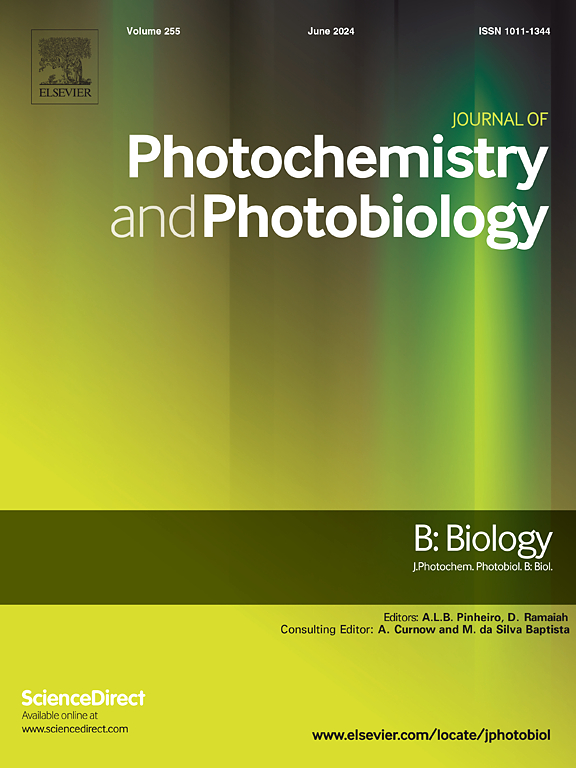Comparative investigation of structural properties and biological applications of chemical and biogenic synthesis of zirconium dioxide (ZrO2) nanoparticles using Passiflora edulis
IF 3.9
2区 生物学
Q2 BIOCHEMISTRY & MOLECULAR BIOLOGY
Journal of photochemistry and photobiology. B, Biology
Pub Date : 2025-02-01
DOI:10.1016/j.jphotobiol.2024.113089
引用次数: 0
Abstract
Over the last decade, the environmental and wellness cost of antibiotic drug resistance to the societies have been astounding and require urgent attention Metal oxide nanomaterials have been achieved a pull-on deal with its entire applications in biological and photocatalytic applications. The present study conducts a comparative investigation on chemical and biogenic synthesis of zirconium dioxide (ZrO2) nanoparticles aimed at enhancing their efficacy in their applications. The plant extract of Passiflora edulis act as a reducing and capping properties offering a sustainable and eco-friendly alternative. ZrO2 nanoparticles have drawn a lot of scrutiny owing to their potential uses in numerous fields, including medicine and environmental remediation. Thereby produced ZrO2 nanoparticles were synthesized by employing sustainable techniques, and their successful production and their uses were confirmed by characterization by XRD, FTIR, UV–visible spectroscopy, SEM, EDAX, PL, TEM, XPS, TGA and Raman spectroscopy. The zirconia nanoparticles synthesized using chemical and green methods exhibited ultraviolet-visible (UV–Vis) absorption maxima at 221 and 224 nm, respectively, demonstrating their synthesis. X-ray diffraction research revealed that the nanoparticles possess a tetragonal shape, with mean particle sizes of 11 nm and 7 nm, respectively. The synthesized ZrO2 nanoparticles (ZrO2 and Ext-ZrO2) exhibited inhibitory effects against Gram-positive strains (Bacillus subtilis and Staphylococcus aureus) and Gram-negative germs (Escherichia coli and Pseudomonas aureus), with zones of inhibition measuring (12, 8 mm), (8, 11 mm), (12, 15 mm), and (7, 12 mm) correspondingly. The antitumor activity of ZrO2 and Ext-ZrO2 was assessed using human colon cancer cells (HT29). The MTT assay was employed to assess the cytotoxicity of ZrO2 nanospheres on the HT-29 cell line at various concentrations (7.5, 15.6, 31.2, 62.5, 125, 250, and 500 μg/ml). The HT29 cell line exhibits a reduction in cell viability from 96 % to 34 % when the concentration of ZrO2 nanoparticles escalates. The photocatalytic activity of ZrO2 and Ext-ZrO2 exhibited absorbance deterioration at around 445 nm, resulting in the discoloration of Rh B dye under UV light irradiation after 100 min, achieving maximal degradation rates of 96 % and 99 %, respectively. Consequently, the synthesized ZrO2 and Ext-ZrO2 may be utilized in antibiotic formulation, pharmaceutical sectors, and photocatalysts.
利用西番莲化学和生物源合成二氧化锆纳米粒子的结构特性和生物应用比较研究。
在过去的十年中,抗生素耐药性给社会带来的环境和健康成本已经令人震惊,需要迫切关注。金属氧化物纳米材料在生物和光催化应用方面已经取得了全面的应用。为了提高纳米二氧化锆(ZrO2)的应用效率,本文对化学合成和生物合成纳米二氧化锆进行了比较研究。西番莲植物提取物作为一个减少和封顶性能提供可持续和环保的替代品。ZrO2纳米颗粒由于其在包括医学和环境修复在内的许多领域的潜在用途而引起了人们的广泛关注。通过XRD、FTIR、紫外可见光谱、SEM、EDAX、PL、TEM、XPS、TGA和拉曼光谱等表征手段,证实了ZrO2纳米颗粒的成功制备及其应用价值。化学法和绿色法合成的氧化锆纳米粒子分别在221 nm和224 nm处具有最大紫外-可见(UV-Vis)吸收,证明了它们的合成。x射线衍射研究表明,纳米颗粒呈四边形,平均粒径分别为11 nm和7 nm。合成的ZrO2纳米颗粒(ZrO2和Ext-ZrO2)对革兰氏阳性菌(枯草芽孢杆菌和金黄色葡萄球菌)和革兰氏阴性菌(大肠杆菌和金黄色假单胞菌)具有抑制作用,抑制区分别为(12、8 mm)、(8、11 mm)、(12、15 mm)和(7、12 mm)。用人结肠癌细胞(HT29)检测ZrO2和Ext-ZrO2的抗肿瘤活性。采用MTT法评价不同浓度(7.5、15.6、31.2、62.5、125、250、500 μg/ml) ZrO2纳米球对HT-29细胞株的细胞毒性。当ZrO2纳米颗粒浓度升高时,HT29细胞系的细胞存活率从96%下降到34%。ZrO2和Ext-ZrO2的光催化活性在445 nm左右出现吸光度下降,导致Rh B染料在紫外光照射100 min后变色,最大降解率分别达到96%和99%。因此,合成的ZrO2和Ext-ZrO2可用于抗生素制剂、制药部门和光催化剂。
本文章由计算机程序翻译,如有差异,请以英文原文为准。
求助全文
约1分钟内获得全文
求助全文
来源期刊
CiteScore
12.10
自引率
1.90%
发文量
161
审稿时长
37 days
期刊介绍:
The Journal of Photochemistry and Photobiology B: Biology provides a forum for the publication of papers relating to the various aspects of photobiology, as well as a means for communication in this multidisciplinary field.
The scope includes:
- Bioluminescence
- Chronobiology
- DNA repair
- Environmental photobiology
- Nanotechnology in photobiology
- Photocarcinogenesis
- Photochemistry of biomolecules
- Photodynamic therapy
- Photomedicine
- Photomorphogenesis
- Photomovement
- Photoreception
- Photosensitization
- Photosynthesis
- Phototechnology
- Spectroscopy of biological systems
- UV and visible radiation effects and vision.

 求助内容:
求助内容: 应助结果提醒方式:
应助结果提醒方式:


